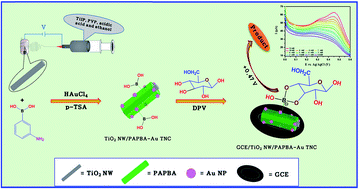Highly selective non-enzymatic electrochemical sensor based on a titanium dioxide nanowire–poly(3-aminophenyl boronic acid)–gold nanoparticle ternary nanocomposite
Abstract
A novel three component (titanium dioxide nanowire (TiO2 NW), poly(3-aminophenyl boronic acid) (PAPBA) and gold nanoparticles (Au NPs)) based ternary nanocomposite (TNC) (designated as TiO2 NW/PAPBA–Au TNC) was prepared by a simple two-stage synthetic approach and utilized for the fabrication of a non-enzymatic (enzyme-free) glucose (NEG) sensor. In stage 2, the PAPBA–Au NC was formed by oxidative polymerization of 3-APBA using HAuCl4 as oxidant on the surface of pre-synthesized TiO2 NW via electrospinning (stage 1). The formation of PAPBA–Au NC as the shell on the surface of the TiO2 NW (core) was confirmed by field emission scanning electron microscopy (FE-SEM). Notably, we obtained a good peak to peak separation, and a high peak current for the redox Fe(CN)63−/4− process indicating excellent electron transfer capability at the glassy carbon electrode (GCE)/TiO2 NW/PAPBA–Au TNC interface. Also, the fabricated TiO2 NW/PAPBA–Au TNC provides excellent electrocatalytic activity towards glucose detection in neutral (pH = 7.0) phosphate buffer solution. The detection of glucose was monitored using differential pulse voltammetry. The obtained sensitivity and detection limits are superior to many of the TiO2 based enzymatic and non-enzymatic glucose sensors reported in the literature. Furthermore, the TiO2 NW/PAPBA–Au TNC sensor is preferred because of its high selectivity to glucose in the presence of co-existing interfering substances and practical application for monitoring glucose in human blood serum samples.



 Please wait while we load your content...
Please wait while we load your content...